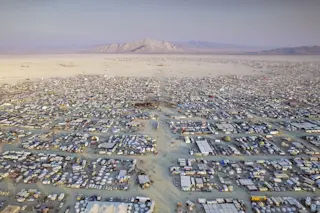Every year around Labor Day weekend, about 75,000 people converge on the Black Rock Desert in Nevada to build a city. Occupying more than 14,000 acres, the pop-up metropolis features distinctive neighborhoods, extensive dining and entertainment, even a small airport. I find no hint of this when I visit the playa, or desert basin, on a sunny afternoon in March. All I see is a flat expanse of white alkaline soil, nearly identical to what pioneers described in their 19th-century journals.
The disappearing act is by design. It’s one of the core attributes of Black Rock City, guided by the tenets of the event for which this temporary metropolis is built: the annual pyrotechnic extravaganza known as Burning Man. Yet the weeklong festival’s leave-no-trace ethos has not stopped archaeologist Carolyn White from studying the city as she would any other vanished civilization. In fact, the cyclicality is one of the ...















